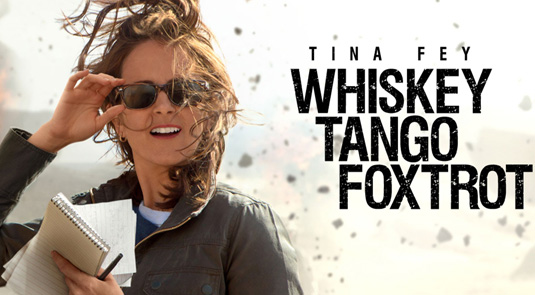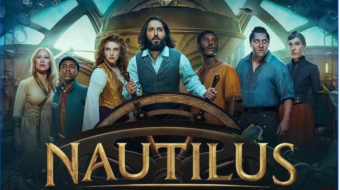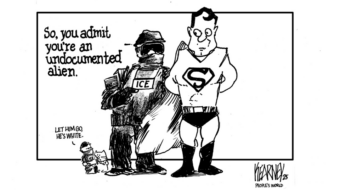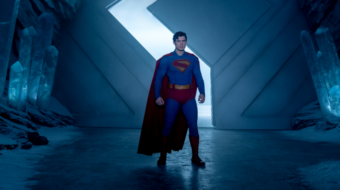
Hot on the heels of Spotlight‘s Oscars for Best Picture and Original Screenplay comes another feature about reporting. In Whiskey Tango Foxtrot Tina Fey stars as Kim Baker, an unprepared cable TV producer and/or newswriter who is “drafted” to become an embedded war correspondent in Afghanistan. Although Fey is best known as a comedienne due to her Saturday Night Live stint and NBC’s droll 30 Rock, plus roles in a variety of movie comedies, and Tango is co-produced by SNL‘s Lorne Michaels and written by SNL and 30 vet Robert Carlock, this Afghan-set film is actually much more of a drama than a comedy. Indeed, like most of the often lame, nearly completely played out SNL (that zombie of the airwaves that refuses to go away and die), most of Tango isn’t funny. MASH this ain’t.
But this is by design. Tango is based on the (supposedly) true adventures of war-reporter-in-the-making Kim Barker and her autobiography The Taliban Shuffle: Strange Days in Afghanistan and Pakistan.
Although the Afghan War winds on forever, paradoxically it is nonetheless largely forgotten by the media and in public discourse. To its credit, Whiskey Tango Foxtrot reminds us of America’s longest war, the role of reportage in a conflict zone, and of female journalists in particular. The film firmly establishes Sarah Palin’s Doppelgänger Tina Fey as also being a serious actress to be reckoned with in a film about a very serious subject. The 45-year-old Fey is glammed down in the role, playing a character around her actual age who is referred to onscreen as a “4” (on the attractive scale) when in Manhattan but a “10” in war-torn Afghanistan, where Western females are in short supply and high demand. Either Fey has bad skin – or her character was made up to look that way – which enhances a sense of realism in this picture that, among other things, shows the cost of war reporting on a correspondent’s love life (or lack of).
But the feature’s sense of realism is undercut by the fact that while there appears to be some digital and stock footage of Afghanistan, Tango was mostly shot in that hotbed of Islamicist insurgency, New Mexico, and Morocco, a North African nation thousands of miles away from Kabul. (News flash: Afghanistan is located in Central Asia, not the Middle East – although judging by what U.S. coverage there is of it, one might never be able to discern this.) Of course, shooting on location in Afghanistan – where there is, you know, real shooting – would be far too dangerous. I’m certainly not implying that stars like Fey are chickens for not making movies in conflict zones. But Tango‘s realism is further diminished because like, say, 2008’s Iraq-set The Hurt Locker, it provides viewers with absolutely no context as to how Washington got bogged down in this seemingly never ending quagmire in a nation that has defied empires going all the way back to Alexander the (not so) Great. (A map of Afghanistan accompanies the “Those who refuse to learn from history are doomed to repeat it” entry in the encyclopedia of fools.)
Tango opens with a scene clearly labeled onscreen as “2006,” and the ensuing bombing is, to the best of my ability to hear correctly, blamed on ISIS – although those terrorists du jour did not emerge as such until about five years later. Tango also shows, without disavowing, the cozy relationship between the U.S. military and “embeds,” as carefully controlled correspondents report on the troops whom their very lives depend upon. What’s next? Having members of movie crews and casts review the films they work on, with independent critics barred from sets, screenings, press days, etc.?
In addition to Fey, whose memorable Palin impression has always tickled the American fancy, the cast includes some notables, including Billy Bob Thornton as General Hollanek, a professional warrior who is PR savvy and cuts deals with Baker. Martin Freeman – who interestingly played pop culture’s most famous Afghan War veteran, Holmes’ colleague Dr. Watson in Mr. Holmes – portrays Tango‘s Scottish war correspondent Iain MacKelpie. The Broadway actress Cherry Jones is relegated to a cameo as a TV news executive who clashes with Baker.
The excellent actor Alfred Molina, often cast in a variety of ethnic roles, depicts a high-ranking Afghan politician. In fact, Molina was born in London to an Italian mother and Spanish father. Connecticut-born Christopher Abbott plays another purportedly Afghan character. Sheila Vand, an actress of Iranian ancestry who appeared in 2013’s pro-CIA propaganda pic Argo, plays Lebanese journalist Shakira Khar, who quips that Baker’s back story is “the most American-white-lady story I’ve ever heard.”
Nevertheless, Tango perpetuates that age-old Hollywood tradition of setting stories (more often than not shot at studio backlots or inauthentic locations) in the “exotic” Third World, starring the story’s main characters – Westerners – with a few token supporting characters (played by one “ethnic” type or another, fobbed off as natives) to provide (literally) local color, while the plots revolve around the white stars and their derring-do. Just consider the fact that La-La-land’s most famous African character is Lord Greystoke, an English aristocrat. In fact, the next role for Tango co-star Margot Robbie, an Australian actress who plays British war correspondent Tanya Vanderpoel, is as Jane in the upcoming The Legend of Tarzan. As the current debate about diversity (or the lack of) in moviedom continues in the wake of the Cloroxed Oscars, these points should be taken into account.
Some may find redemption in the form of female career and sexual empowerment, and the fact that the overlooked war in Afghanistan receives its due with screen time in Tango (even if shot in New Mexico and Morocco). The flick also has some good, ironic use of rock songs – like countless Vietnam movies, modern American war pictures aren’t complete unless they have a rock ‘n’ roll score full of oldies to boogie to. But Tango sheds more heat than light on the Afghan War debacle. The film’s title is never explained, although Whiskey Tango Foxtrot presumably refers to call words that suggest the initials “WTF” – which seems like an appropriate question to ask about imperialist America’s endless, losing war in Afghanistan.
Journalism is currently besieged, whether by the Internet and various forms of new media or by protofascist presidential candidates calling for First Amendment restrictions. So films exalting about this beleaguered profession’s noble calling are to be welcomed, although in addition to Spotlight, that wonderful ode to investigative reporting, the great Gary Webb anti-CIA biopic Kill the Messenger, and documentaries such as HBO’s recent Jim: The James Foley Story, are better films about war correspondents and reporting on the frontline.










